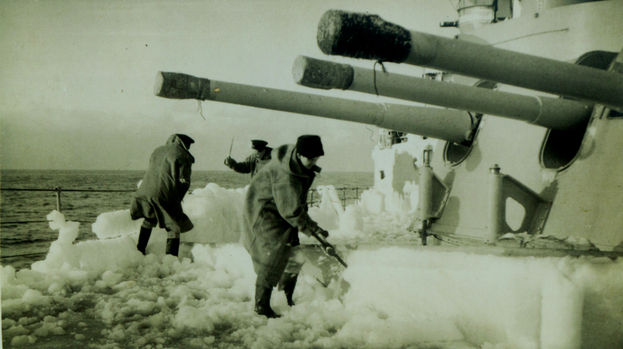There are places out in the Arctic Seas where the air is so bitingly cold each breath burns your lungs like frozen fire.
Where blizzards of snow swirl out of heavy skies and temperatures drop so low your eyelids freeze together, leaving you blind.
Then all you can hear is the roar of the giant waves, crashing down like steel-grey towers and pummelling ships with icy fists down toward the ocean floor.
It was through this treacherous battleground of water and ice that tens of thousands of our servicemen were sent during the Second World War on what Winston Churchill would later describe as the “worst journey in the world”.
“We faced 40 meter walls of cold, heavy water,” recalls veteran James Simpson, who served upon the HMS Devonshire. “There were terrific, terrible, mountainous waves in the Arctic waters. You had to go with the sea or you would sink. You can’t turn around once you’re out there. You can’t stop or go back. You have to go with the sea wherever she wants to take you.”
The son of a local Edinburgh farmer, James, 91, enrolled in the Arctic Convoys when he was barely 19, sailing from Scotland on a 1,600-mile journey past enemy-held German shores, carrying vital supplies to the Russian allies during the war.
He’s been awarded the Arctic Star, the Atlantic Star, the 1939-1945 Star, The War Medal, The Russian Convoy Medal and even been gifted a pineapple from the King of Norway for his service.
But this week the World War Two veteran and thousands of his former comrades are being paid tribute through one of Scotland’s oldest traditions – storytelling.
In a new exhibition opening in their honour at the National War Museum in Edinburgh, the men who bravely endured some of the most treacherous wartime missions in history are having their stories immortalised in a public display of their diaries, letters, photographs and uniforms.
“I’m going to be going along to see it all with my wife Sybil,” said James. “I’m looking forward to seeing everything together – it’s important that what happened is remembered.”

A packing label marking the support for the convoys.
The convoys honoured the allied agreement to provide support for Russia during the war, bringing everything from tanks to medical supplies in order to ensure an allied victory. Those on the convoys risked their lives trying to get to the Red Army through a gauntlet of German warplanes and U-boats who kept up a constant attack throughout their voyage.
Facing waves the height of four double-decker buses and sub-zero temperatures which meant death for any man who fell into it, it was the Arctic sea herself though, as much as the constant risk of German attack which threatened their lives.
As James explains: “The seas were rough, very rough. The waves threatened to capsize us many times but my ship was very lucky.
“She had a brilliant captain at her helm – a Glaswegian named Captain Bain. It was rumoured he’d lost his wife and child in the London Blitz. There were 800 men on that ship. Only six of them were Scotsmen and we were all nick-named Jock, but there’s a streak of luck in the Scots.
“The Captain could dodge the torpedoes and the mines. He could turn that ship on a sixpence. Those ships that did sink though had great loss of life as no-one could survive the frozen seas.”
Conditions were so bitterly cold that ice had to be continually chipped away from the decks to stop the weight of it capsizing the ships, and windows were so frozen that captains and navigators on the bridges could not see where they were going.

Sailors faced the constant task of chipping ice off the ships to keep them from sinking.
“We were always on constant alert too, so we couldn’t ever relax,” adds James. “We had hammocks below deck but they were hardly slept in – we were always at our action stations because the German submarines would creep up so quietly you never knew where they were.
“We slept with our clothes on so we would always be ready. The Germans tended to come at dusk, when it was the hardest point in the day to see them coming.”
The conditions were seen as so treacherous that Churchill himself privately admitted that he would have been happy if even half of the Convoys got through. Of the 811 merchant ships that sailed, 707 arrived safely.
Despite this though, over 3,000 sailors still lost their lives to the German guns and the icy waters and 87 merchant ships and 18 British warships were sunk.
“It was horrendous the loss of life,” said James. “On one mission we had to watch as our air fighters went down, knowing that we couldn’t turn back to rescue them from the sea. It was terrible.
“But there was a strong camaraderie among the men. I think we coped because we were so young and because our training kicked in, in what was a highly stressful environment.
“We took on many missions during the war, from providing a guard for world leaders to attacking German-occupied coastline where they were experimenting with the Atomic bomb.
“We even assisted in transporting the King of Norway across the sea safely, which is why we were sent the pineapple.”
James smiles, adding: “They sent my mum a hamper after the mission as a thank you. I don’t remember much about what was in it but I do remember there was a pineapple.”
In total, more than 66,000 Royal Navy sailors and merchant seamen took part in the Arctic Convoys carrying four million tons of cargo including tanks, planes, fuel and food to help the Russians fight Germany’s advances on the Eastern front.
When the war ended, James returned to Edinburgh and happened upon a local farmer’s daughter, Sybil, who he insists he knew was the girl for him.
 James Simpson with his wife Sybil at their Edinburgh home.
James Simpson with his wife Sybil at their Edinburgh home.
“We were at one of the farmer’s dances, quite popular back then,” smiles James. “We just knew it was right. I set sail five days later for Japan but while I was en-route the bomb was dropped on Hiroshima. I returned later that year and we were engaged, married and I left the service for good.”
When the war ended, James and those on the convoys were awarded the Atlantic Star but it would take almost 70 years for the bravery of James and his fellow servicemen to be recognized fully by Britain.
Earlier this month 39 of the veterans, including James, were finally awarded the Arctic Star by their government and by their country after a successful campaign was launched to honour them.
 James Simpson’s medals – the Arctic Star can be seen third on the right.
James Simpson’s medals – the Arctic Star can be seen third on the right.
“It was lovely to finally receive it,” said James, “Though I wish the others were still alive to receive the recognition they deserve. I’d go back to the Navy in a heartbeat though, it meant a lot to me to be part of it and I’m looking forward to seeing the exhibition of our stories.”
The exhibition is free with admission to Edinburgh Castle from Wednesday, 29 with Castle admission prices currently: Adult £16.00, Child £9.60, Concession £12.80, Child under 5 free.

